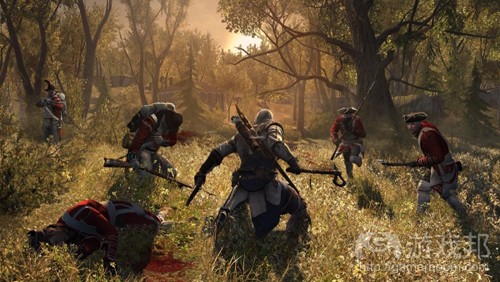开发者应根据整体游戏体验设置难度
作者:Paul Suddaby
每个玩家和游戏记者谈到电子游戏时总是不免提及该游戏的难度。最后人们的结论不是“太简单”就是“太困难”,但实际上我们应该更深入探讨这一话题,因为它的处理方式可能彻底改变玩家的游戏体验。我将在本文阐述低难度对游戏体验的多种影响。
难度的定义:玩家完成游戏体验所需掌握的技能。
易用性陷阱
我曾在之前的文章中提到,难度(应该融入电子游戏设计的核心之中。更准确的说法是,高层次的复杂度,以及出色的挑战为游戏体验带来的好处。
但这并不意味着所有游戏都应该很困难。事实上,过去几年的游戏设计还出现了一个愈发容易的趋势,以便吸引更多并不擅长玩高难度游戏的休闲群体。
这种情况产生了一种有趣的争论:更简单、更通俗的游戏是否就比更复杂、困难、晦涩的游戏更易吸引大量用户?我个人认为两种体验在游戏领域都有各自的空间。但如果开发者试图为游戏增加更多易用性,而游戏本身的设计并不支持这种设置,那就会产生许多问题。
也许在这方面没有哪一款现代游戏系列会比《刺客信条》更可恶了。这个系列是复杂的游戏,拥有丰富的可探索世界,精致的故事情节,充满许多需要玩家理解和掌握的多种不同游戏机制。这是休闲玩家不会尝试的游戏类型,它们是专为硬核群体而设计的游戏。
不幸的是,每款《刺客信条》游戏都有同样的致命弱点,而这又严重威胁了游戏的基本核心——这些游戏太简单了。
《刺客信条》的败笔
《刺客信条》有三个基本的玩法支柱:战斗、自由奔跑以及潜行(游戏邦注:不过随着该系列的发展,潜行的重要性日趋削弱)。除了一些在更新的游戏中所出现的元素,例如海战或塔防,你在《刺客信条》中所做的一切都可以归结为这三种玩法,或者这三者的合体,尽管游戏中并没有明显强调战斗元素。
在过去几年中,该系列的这些玩法备受诟病,有人认为其中的潜行元素令人抓狂,认为自由奔跑过于机械化。本文则将主要讨论这三者中最重要的一个元素:战斗。
《刺客信条》中的战斗是件令人愉快的事情,充满野蛮手段和快速的连击,但却太过于简单了。你在《刺客信条》的遭遇战中几乎不可能失败,无论你面对多少敌人。
这其中有多个原因,但主要还在于你实在是过于强大了,拥有快速杀死多个敌人的能力,在自己倒下前能够得到数量惊人的命中率。因为你可以通过掉头与追踪者打斗而避免多数潜行和自由奔跑环节,所以这种轻松的战斗常让游戏体验变得无足轻重。
例如,在《刺客信条3》中,玩家很难在自己的角色能够干掉一只熊的时候,觉察到自己正受训成为刺客高手。其他场景则让人觉得是在浪费时间,例如等待暴风雪降临以作掩护,潜入英国哨所,而是事实上你的角色完全可以轻易打败那支没有什么武器力量的军队。
《天空之剑》的无趣
另一个让游戏因易用性而受困的例子就是最新版《塞尔达传奇:天空之剑》,这款游戏中充满许多谜题——如果你有机会破解那应该会很有趣。
不幸的是,你有太多可提供帮助的同伴,它们会积极提供谜题解决方法,经常在你还没有意识到之前就告诉你如何解琐最后一个房门。你无需听取她的建议,但她仍会一直提醒你,她有话要跟你说。
这种提供帮助的伙伴一直是《塞尔达》3D版问世以来的设计惯例,但其中表现最为典型的当属《天空之剑》中的同伴。
首先我要声明《天空之剑》和《刺客信条》都是质量上乘之作,我指责的是它们缺乏难度,或者说是其难度并不适用于游戏机制或主题,其休验也会因此而受害。
《刺客信条》的人物设计很强大,《天空之剑》的地下城设置也很符合该系列的历史,但它们也不是毫无瑕疵,难度就是其中之一。
简单的游戏就很糟糕吗?
这里我们提到的只是那些过于简单,或者因为缺乏难度而影响整体效果的游戏。但这并不意味着挑战性较小的游戏就没有生存空间了,也不是说任何真正的“硬核”游戏体验都要很困难。这里的结论是:设计核心游戏系统时,一定要将难度铭记在心。
实际上我并不是说要把困难的游戏做成简单的,或者将简单的游戏做成困难的。我们在这里所举的游戏之所以存在败笔,是因为其机制和主题无法兼容缺乏难度的特点。它们简单化了玩法的“游戏”元素,稀释了交互无素,导致其他游戏体验无法相容。
成功案例
现在让我们看看成功利用了简单优势,提供了无挫折体验,没有因为难度而产生叙事或主题干扰元素,并且对技能不佳的群体极具易用性的游戏典型。这就是thatgamecompany推出的《Journey》。
《Journey》是一款关于两个陌生人之间美妙的人际互动。游戏很短,仅持续两个小时,基本上由前进和爬山组成。你也可以根据自己所搜集到的物品飞翔一小段距离,但这些都取决于你的选择。
这款游戏也不存在时间限制,你不会死亡,也只有一种让自己受害的可能,并且这种影响只能算是一种心理上的感伤,并不会对游戏进程造成任何影响。这款游戏极其简单——它基本上是在自娱自乐。
但它一点也不无聊,因为游戏中的每一样东西都很令人激动。它拥有精妙绝伦的图像,音乐插曲也颇令人陶醉。但这些都不是游戏的关键所在,真正让你无法自拔的却是其他玩家的行为。
你在这个游戏世界中旅行时会遇到其他玩家,你不会知道他们的在线ID,除了你的角色所发出的一些声响之外,你也不会同他们进行什么交流。但由于游戏中的所有设计都支持玩家进行合作,你们就会一起旅行,会对这个你一无所知的眼前人产生依恋,这种感觉很奇妙。
但我并不是说《Journey》以及所有的这一切同难度有直接的关联。可以说,它如果没有这么简单,《Journey》就行不通了。这款游戏关注的是人际互动,美丽的场景和音乐,而这些元素都无法因更具难度的玩法体验而获得提升。
事实上,如果游戏更具挑战性,玩家在与他人互动时的出发点可能就不是自己的实际需求,而是自己身为游戏玩家所能发挥的作用。如果《Journey》中充满复杂的谜题,有心帮助玩家解谜的其他人可能会束手无策,而玩家之间的互动可能会由游戏系统所主宰,而不是由玩家自己来决定。通过让一切简单化,《Journey》成功避开了这个问题,让玩家根据自己的意愿彼此互动。《Journey》实在不能算有什么难度,它只存在于游戏背后核心设计的执行。
这里的经验就是:设计游戏核心系统时一定要将难度设置牢记在心。不要考虑你的游戏是否太难,缺乏易用性。如果你想制作一款人人都可以玩的游戏,但不考虑游戏体验,那就设计一种符合这一目标的体验吧。不要试图在明知游戏核心设计无法兼容的情况下,削足适履地强塞易用性。
但是,也不要认为难度与易用性就是矛盾的对立面,它们通常都有交集。记住,即使是最复杂和引人入胜的游戏也可能非常简单,而极为简单的游戏也可能极具挑战性。重要的是根据整个游戏体验设计有意义的难度。
原文发表于2013年2月11日,所涉事件及数据以当时为准。(本文为游戏邦/gamerboom.com编译,拒绝任何不保留版权的转载,如需转载请联系:游戏邦)
Easy Mode: When Easy is Okay
Paul Suddaby
Nintendo Hard Mode: It Was Acceptable in the Eighties
Every gamer and games journalist will invariably end up talking about difficulty when discussing a video game. This often takes the form of a comment saying it’s “too easy” or “too hard”, but it’s a topic that deserves to be looked at in much more depth, as the way it is handled can completely reshape a player’s experience with a game. In this article, I’ll look at the many ways low difficulty can affect a game experience.
Definition of Difficulty: The amount of player skill required to progress through a game experience. (From my previous article.)
The Accessibility Trap
As I stated in the previous article of this series, difficulty is (or at least should be) baked into the very core of any video game’s design. More specifically, we talked about high levels of difficulty, and the benefits great challenge can bring to an experience.
However, this doesn’t mean all games need to be difficult. In fact, there has been a growing trend in game design over the last few years for easier and easier video games, mostly in order to appeal to a more casual audience who developers seem to think aren’t capable of enjoying more difficult games.
I don’t know about you, but this is how I game.This situation has brought up an interesting debate: is an easier, more accessible game capable of reaching a wide audience of players better than a more complex, difficult and nuanced game that fewer will be able to understand and appreciate? I personally believe that both types of experiences have their place in the gaming landscape. Problems arise, however, when developers try to make their game into something it isn’t, trying to increase its accessibility when that is not appropriate in the context of the game’s design.
Perhaps no modern game series is more guilty of this sin than the Assassin’s Creed franchise. These are very complex games, with rich worlds to explore, nuanced storylines spanning multiple instalments and a plethora of different game mechanics to grasp and understand. These are the types of games casual players don’t play; these games are designed for the hardcore.
Unfortunately, every single Assassin’s Creed game suffers from the same fatal flaw which threatens to break the very core of its functioning: the games are just too easy.
Assassin’s Ease
The Assassin’s Creed games hinge on three basic gameplay pillars: combat, free running and stealth (although the latter has taken more and more of a back seat to the others as the series has progressed). Other than a few key distractions present in the more recent games, such as naval combat or tower defence, everything you do in Assassin’s Creed can be boiled down to one of these three pillars, or a combination thereof, though there is a noticeable emphasis on combat.
There have been many criticisms thrown at these pillars of the franchise over the years, with the stealth often being called frustrating and the free running cited as being overly automated. However, for the sake of this article we will look at the most prominent of the three: combat.
Combat in Assassin’s Creed is an exhilarating affair, filled with brutal executions and flashy combos, but it’s entirely too easy. It’s almost impossible to fail during a combat encounter in any Assassin’s Creed game, no matter how many enemies you are fighting.
There are a multitude of reasons for this, but it mostly comes down to the fact that you are simply overpowered, sporting the ability to instantly kill most enemies and take a ridiculous amount of hits before you are downed. Since the vast majority of stealth and free running sections can be completely avoided by turning around and fighting your pursuers, the ease of combat often serves to trivialize the experience.
Five versus one? Come at me.In Assassin’s Creed 3, for example, it’s difficult for the player to feel like they are training to become a master assassin when their character has proven capable of winning fist fights against bears as a teenager. Other scenarios simply feel like a waste of time, such as waiting for a snowstorm to use as cover to infiltrate a British outpost when your character can easily defeat the entirety of the red coat forces armed with nothing but a rabbit snare.
Bolero of Boredom
Another great example of a game getting caught in the accessibility trap is the newest Legend of Zelda game, Skyward Sword. The game is filled with many devilish puzzles that would be tons of fun to solve – if only you were given the chance to.
Unfortunately, you are burdened with an overly helpful companion who feels the need to give you the solution to puzzles proactively, often telling you how to unlock that pesky door at the end of the room before you even had the time to notice it was locked. You do not need to listen to her advice, but she will keep reminding you that she has something to say until you do.
This type of helpful partner has been a staple of the Zelda series since its 3D début, but never have the companions been as overbearing as the one in Skyward Sword.
Now before anybody runs around calling me names because I’m ragging on some very well received games, let me say that Skyward Sword and the Assassin’s Creed games are all quality products. All I’m saying is that their level of difficulty, or lack thereof, is not appropriate in the context of the mechanics or the mythos, and the experience is definitely hurt because of it.
Being a badass assassin is still empowering, and Skyward Sword’s dungeons are still as elegantly crafted as one would expect given the series’ history, but they aren’t without flaw, and difficulty is one of them.
Wow, aren’t you a smart cookie.
So Easy Games Are Bad?
What we’ve just looked at are games that are too easy, or rather games who were hurt by their overall lack of difficulty. This however does not mean that there is no place for less challenging games, and it also doesn’t mean that any serious “hardcore” game experience needs to be difficult. What it all boils down to is something that risks becoming a theme in this series: keep difficulty in mind when designing the core systems behind your game.
Essentially I’m saying to not make hard games easy or easy games hard. The games we looked at stumbled because their mechanics and themes did not mesh well with their lack of difficulty. They were simplifying the “play” part of gameplay, diluting the interactive element to the point where the rest of the experience no longer fit.
Who Does It Right?
Let’s now look at a game that takes advantage of all the benefits of being easy, namely providing an experience without frustration, without interruption of narrative or thematic flow because of difficult sections and with extreme accessibility to a less skilled or determined audience. This game is thatgamecompany‘s Journey.
Journey, for those of you who don’t know, is a about beauty and personal interaction between two strangers. The game is short, lasting only a couple of hours, and basically consists of walking towards and then scaling a mountain. You can fly a little bit depending on how many collectibles you find along the way, but these are entirely optional.
There are also no time limits, it’s impossible to die and there is only one instance where it’s possible to harm yourself in any way, though the repercussions can only really be considered sentimental as they have no impact whatsoever on progress. The game goes beyond even being easy: it practically plays itself.
LamouraGames’ video walkthrough of Journey. Contains spoilers (as far as such a game can have spoilers).While I don’t think the aspect of human interaction and difficulty can’t really be properly delivered through watching somebody else play the game, I do think videos express very well the beauty and serenity on display here.Unlike what you would expect, though, it’s not boring at all, because everything in the game is so breathtaking. The graphics are unbelievably beautiful (just look at the screenshot below) and the musical score will sweep you away into another world. But none of this is really the point of the game; what really hooks you is the other players.
As you traverse the world you will encounter other players, you will not know their online IDs, and you will have no means of communicating with them other than a few small chirps your character can make. Yet somehow, because of the way everything in the game is designed to support cooperation, you will travel together and you will become attached to this person you know absolutely nothing about, and it’s beautiful.
This. This is beautiful.But I’m not here to review Journey and all of this does have a direct link to difficulty. Basically, Journey wouldn’t work if it wasn’t stupidly easy. The game focuses on human interaction and on taking in beautiful vistas and sounds, and none of these things would be improved by a more difficult gameplay experience.
In fact, if the game were more challenging, players wouldn’t necessarily be interacting with each other on the basis of what they wanted to do, but rather on the basis of what they were capable of doing as gamers. If Journey was filled with complicated puzzles, someone who might want to help their partner come up with a solution might not be able to and the interaction between the players would then be governed mostly by the game’s systems rather than by the players themselves. By keeping things simple, Journey manages to avoid this pitfall, letting players interact with each other on their own terms. The difficulty in Journey is trivial, but it only exists in service of the core design tenants behind the game.
The lesson here is exactly the same as it was in the last article: keep difficulty in mind when designing the core systems behind your game. Do not wonder if your game is too difficult to be accessible. If you want a game that anybody can play, regardless of video game experience, then design an experience that suits that goal; do not try and shoehorn in accessibility when it doesn’t fit with the core design of your title.
However, do not think that difficulty and accessibility are one side of the same coin, though they do often intersect. Remember, even the most complex and engrossing games can be very easy and the most simple of games can be incredibly challenging. What’s important is that your game’s difficulty level makes sense within the context of the overall experience.(source:gamedev)











































 闽公网安备35020302001549号
闽公网安备35020302001549号